A Look At Triple-GPU Performance And Multi-GPU Scaling, Part 1
by Ryan Smith on April 3, 2011 7:00 AM ESTThe Test, Power, Temps, and Noise
| CPU: | Intel Core i7-920 @ 3.33GHz |
| Motherboard: | Asus Rampage II Extreme |
| Chipset Drivers: | Intel 9.1.1.1015 (Intel) |
| Hard Disk: | OCZ Summit (120GB) |
| Memory: | Patriot Viper DDR3-1333 3x2GB (7-7-7-20) |
| Video Cards: |
AMD Radeon HD 6990 AMD Radeon HD 6970 PowerColor Radeon HD 6970 EVGA GeForce GTX 590 Classified NVIDIA GeForce GTX 580 Zotac GeForce GTX 580 |
| Video Drivers: |
NVIDIA ForceWare 266.58 AMD Catalyst 11.4 Preview |
| OS: | Windows 7 Ultimate 64-bit |
With that out of the way, let’s start our look at power, temperature, and noise. We did include our jury-rigged triple-CF setup in these results for the sake of a comparison point, but please keep in mind that we’re not using a viable long-term setup, which is why we have starred the results. These results also include the GTX 590 from last week, which has its own handicap under FurMark due to NVIDIA’s OCP. This does not apply to the triple SLI setup, which we can bypass OCP on.
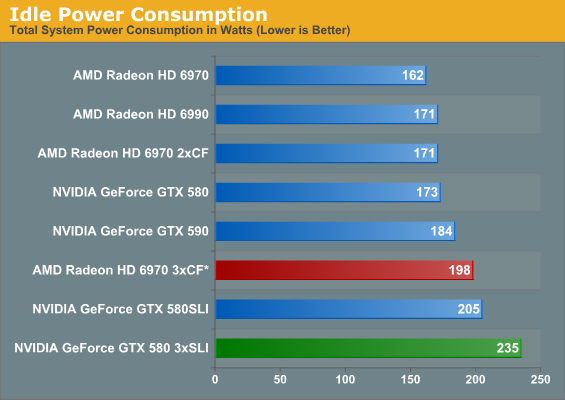
Given NVIDIA’s higher idle TDP, there shouldn’t be any surprises here. Three GTX 580s in SLI makes for a fairly wide gap of 37W – in fact even two GTX 580s in SLI is still 7W more than the triple 6970 setup. Multi-GPU configurations are always going to be a limited market opportunity, but if it were possible to completely power down unused GPUs, it would certainly improve the idle numbers.
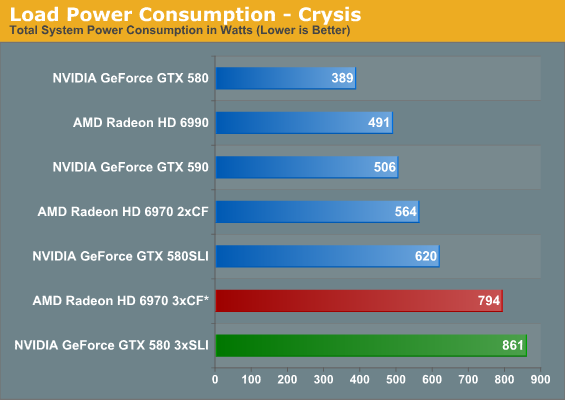
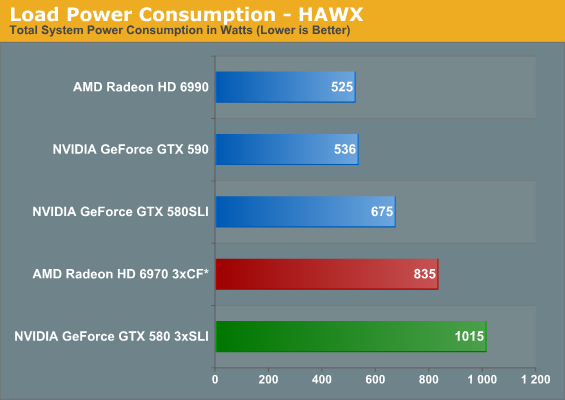
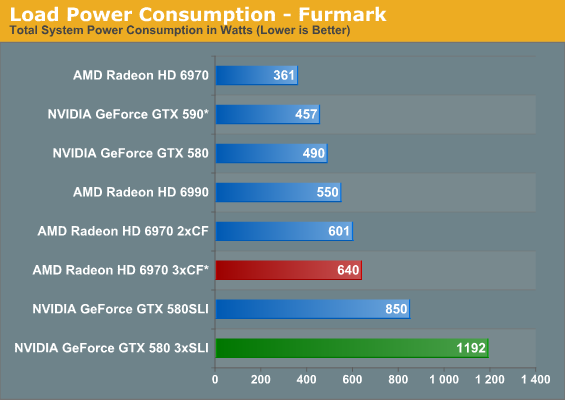
With up to three GPUs, power consumption under load gets understandably high. For FurMark in particular we see the triple GTX 580 setup come just shy of 1200W due to our disabling of OCP – it’s an amusingly absurd number. Meanwhile the triple 6970 setup picks up almost nothing over the dual 6970, which is clearly a result of AMD’s drivers not having a 3-way CF profile for FurMark. Thus the greatest power load we can place on the triple 6970 is under HAWX, where it pulls 835W.
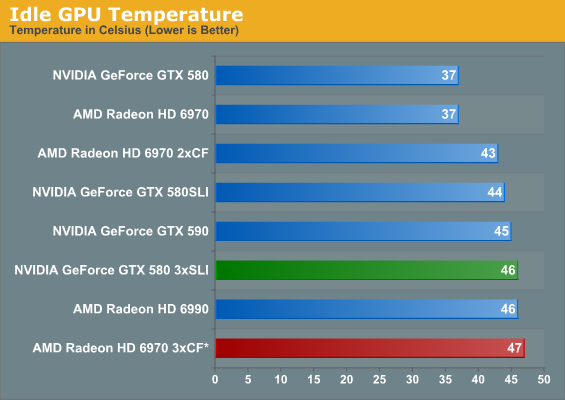
With three cards packed tightly together the middle card ends up having the most difficult time, so it’s that card which is setting the highest temperatures here. Even with that, idle temperatures only tick up a couple of degrees in a triple-GPU configuration.
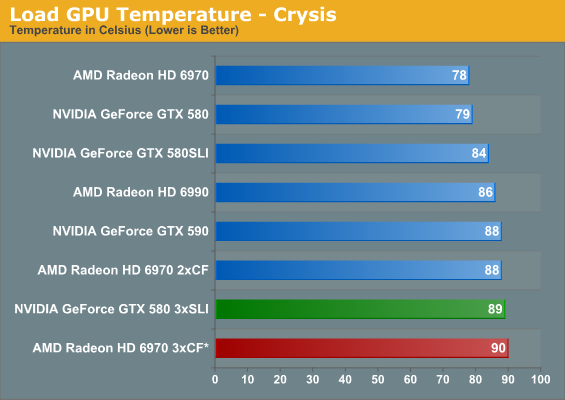
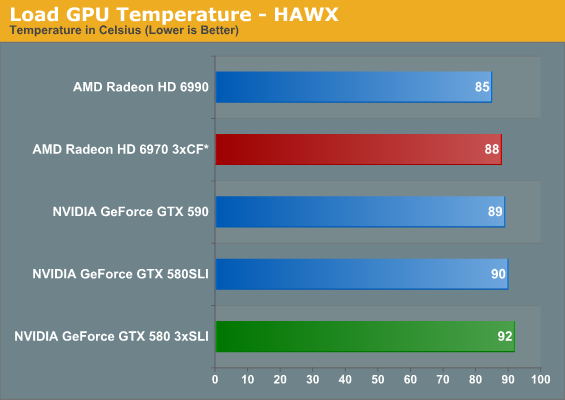

Even when we forcibly wedge the 6970s apart, the triple 6970 setup still ends up being the warmest under Crysis – this being after Crysis temperatures dropped 9C from the separation. Meanwhile the triple GTX 580 gets quite warm on its own, but under Crysis and HAWX it’s nothing we haven’t seen before. FurMark is the only outlier here, where temperatures stabilized at 95C, 2C under GF110’s thermal threshold. It’s safe, but I wouldn’t recommend running FurMark all day just to prove it.
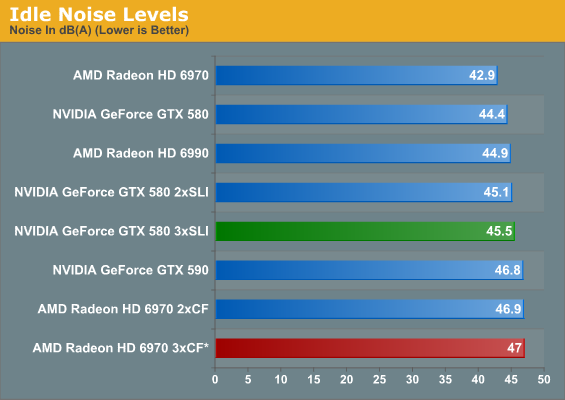
With a 3rd card in the mix idle noise creeps up some, but much like idle temperatures it’s not significantly more. For some perspective though, we’re still looking at idle noise levels equivalent to the GTX 560 Ti running FurMark, so it’s by no means a silent operation.
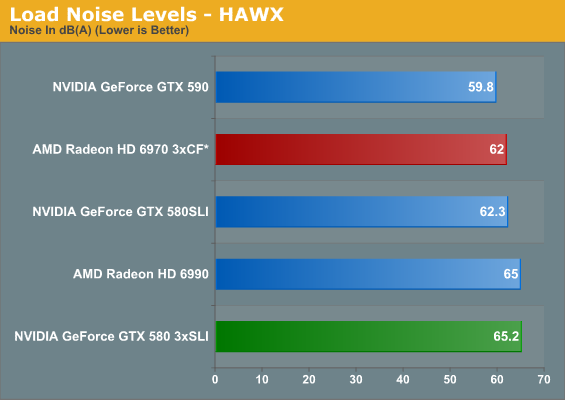
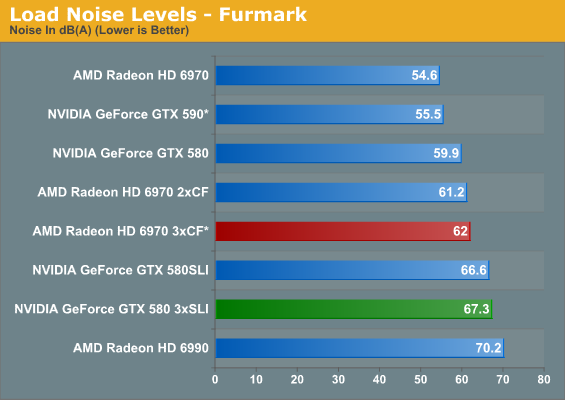
It turns out adding a 3rd card doesn’t make all that much more noise. Under HAWX the GTX 580 does get 3dB louder, but under FurMark the difference is under a dB. The triple 6970 setup does better under both situations, but that has more to do with our jury-rigging and the fact that FurMark doesn’t scale with a 3rd AMD GPU. Amusingly the triple 580 setup is still quieter under FurMark than the 6990 by nearly 3dB even though we’ve disabled OCP for the GTX 580, and for HAWX the difference is only .2dB in AMD’s favor. It’s simply not possible to do worse than the 6990 without overvolting/overclocking, it seems.










97 Comments
View All Comments
marc1000 - Monday, April 4, 2011 - link
Ryan, if at all possible, please include a reference card for the "low-point" of performance. We rarely see good tests with mainstream cards, only the top tier ones.So if you can, please include a radeon-5770 or GTX460 - 2 of these cards should have the same performance as one of the big ones, so it would be nice to see how well they work by now.
Ryan Smith - Wednesday, April 6, 2011 - link
These charts were specifically cut short as the focus was on multi-GPU configurations, and so that I could fit more charts on a page. The tests are the same tests we always run, so Bench or a recent article ( http://www.anandtech.com/show/4260/amds-radeon-hd-... ) is always your best buddy.Arbie - Monday, April 4, 2011 - link
Looking at your results, it seems that at least 99.9% of gaming enthusiasts would need nothing more than a single HD 6970. Never mind the wider population of PC-centric folk who read Anandtech.More importantly, this isn't going to change for several years. PC game graphics are now bounded by console capabilities, and those advance only glacially. In general, gamers with an HD 6850 (not a typo) or better will have no compelling reason to upgrade until around 2014! I'm very sad to say that, but think it's true.
Of course there is some technical interest in how many more FPS this or that competing architecture can manage, but most of that is a holdover from previous years when these things actually mattered on your desktop. I'm not going to spend $900 to pack two giant cooling and noise problems into my PC for no perceptible benefit. Nor will anyone else, statistically speaking.
The harm in producing such reports is that it spreads the idea that these multi-board configurations still matter. So every high-end motherboard that I consider for my next build packs in slots for two or even three graphics boards, and an NF-200 chip to make sure that third card (!) gets enough bandwidth. The mobos are bigger, hotter, and more expensive than they need to be, and often leave out stuff I would much rather have. Look at the Gigabyte P67A-UD7, for example. Full accommodation for pointless graphics overkill (praised in reviews), but *no* chassis fan controls (too mundane for reviewers to mention).
I'd rather see Anandtech spend time on detailed high-end motherboard comparisons (eg. Asus Maximus IV vs. others) and components that can actually improve my enthusiast PC experience. Sadly, right now that seems to be limited to SSDs and you already try hard on those. Are we reduced to... fan controllers?
Thanks,
Arbie
erple2 - Tuesday, April 5, 2011 - link
There are still several games that are not Console Ports (or destined to be ported to a console) that are still interesting to read about and subsequently benchmark. People will continue to complain that PC Gaming has been a steady stream of Console Ports, just like they have been since the PSX came out in late '95. The reality is that PC Gaming isn't dead, and probably won't die for a long while. While it may be true that EA and company generate most of their revenue from lame console rehash after lame console rehash, and therefore focus almost single-mindedly on that endeavor, there are plenty of other game publishers that aren't following that trend, thereby continuing to make PC Gaming relevant.The last several tests I've seen of Motherboard reviews has more or less convinced me that they just don't matter at all any more. Most (if not all) motherboards of a given chipset don't offer anything performance wise over other competing motherboards.
There are nice features here and there (Additional Fan Headers, more USB ports, more SATA Ports), but on the whole, there's nothing significant to differentiate one Motherboard from another, at least from a performance perspective.
789427 - Monday, April 4, 2011 - link
I would have thought that someone would pay attention to if throttling was occurring on any of the cards due to thermal overload.The reason is that due to differences in ventilation in the case, layout and physical card package, you'll have throttling at different times.
e.g. if the room was at a stinking hot 50C, the more aggressive the throttling,the greater the disadvantage to the card.
Conversely, operating the cards at -5C would provide a huge advantage to the card with the worst heat/fan efficiency ratio.
cb
TareX - Monday, April 4, 2011 - link
I'm starting to think it's really getting less and less compelling to be a PC gamer, with all the good games coming out for consoles exclusively.Thank goodness for Arkham Asylum.
Golgatha - Monday, April 4, 2011 - link
I'd like to see some power, heat, and PPD numbers for running Folding@Home on all these GPUs.Ryan Smith - Monday, April 4, 2011 - link
The last time I checked, F@H did not having a modern Radeon client. If they did we'd be using it much more frequently.karndog - Monday, April 4, 2011 - link
Cmon man, you have an enthusiast rig with $1000 worth of video cards yet you use a stock i7 at 3.3ghz??"As we normally turn to Crysis as our first benchmark it ends up being quite amusing when we have a rather exact tie on our hands."
Ummm probably because your CPU limited! Update to even a 2500k at 4.5ghz and i bet you'll see the Crossfire setup pull away from the SLI.
karndog - Monday, April 4, 2011 - link
Not trying to make fun of your test rig, if that's all you have access too. Im just saying that people who are thinking about buying the Tri SLI / Xfire video card setups reviewed here arent running their CPU at stock clock speeds, especially such low ones, which skew the results shown here.